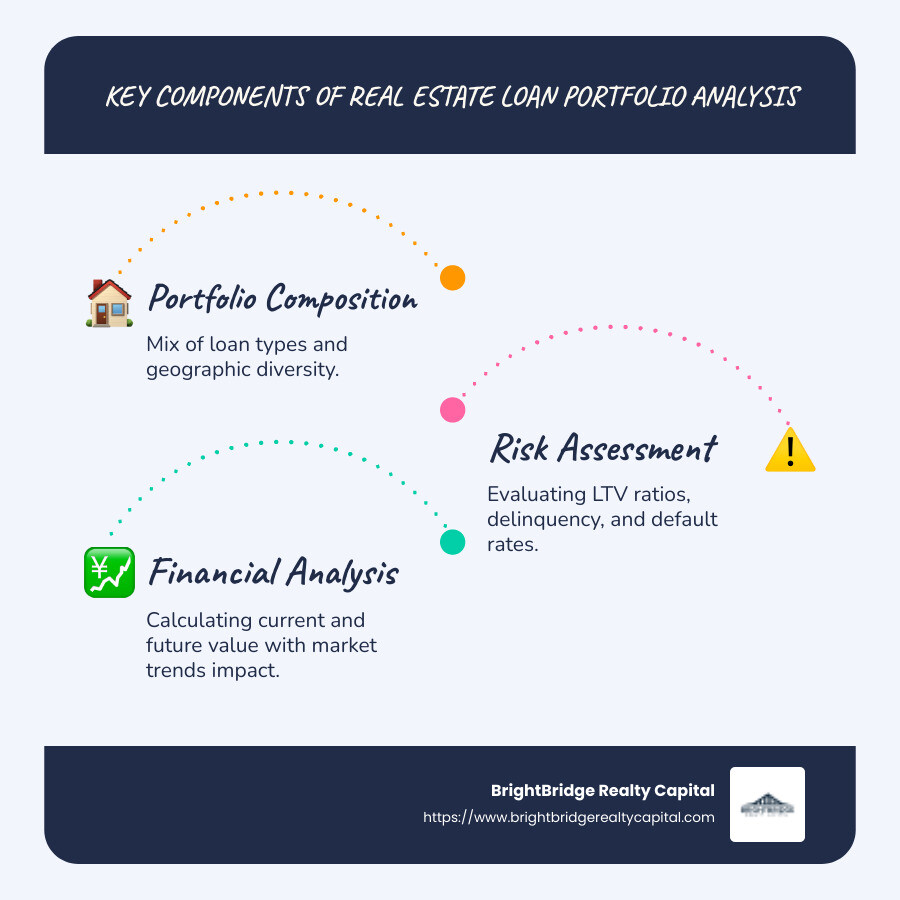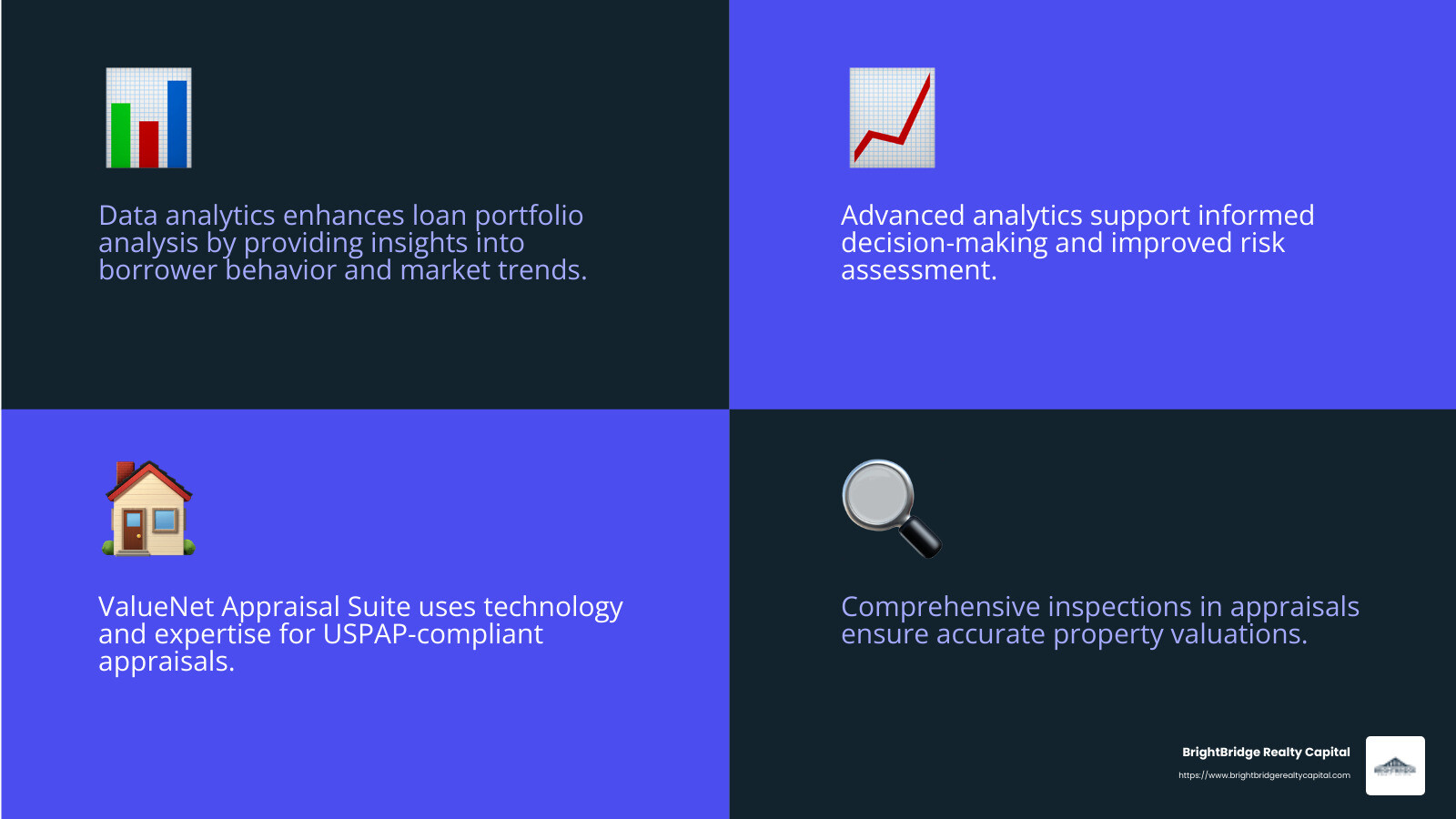Real Estate Loan Portfolio Analysis: A Step-by-Step Guide

Real estate loan portfolio analysis is essential for any investor looking to maximize the financial performance and security of their investments. At its core, it involves examining how well your loan portfolio is performing, assessing the risks associated with it, and determining its financial value.
Here's a quick overview of the key components:
Portfolio Composition: Understand your mix of loans, including types of mortgages and the diversity of geographic locations.
Risk Assessment: Measure potential risks by evaluating factors like Loan-to-Value (LTV) ratios, delinquency, and default rates.
Financial Analysis: Calculate the current and future value of your portfolio, including the impact of market trends on property values.
By focusing on these elements, investors can make informed decisions about their portfolios, ensuring effective risk management and optimal financial gains.

Simple guide to real estate loan portfolio analysis terms:
- commercial real estate portfolio loans
- portfolio loan real estate
- real estate portfolio line of credit
Understanding Real Estate Loan Portfolio Analysis
Key Metrics in Portfolio Analysis
When diving into real estate loan portfolio analysis, it's important to focus on specific metrics that can provide a clear picture of your portfolio's health and potential risks. These metrics help you understand the performance of your loan investments and make informed decisions. Let's break down the key metrics:
1. Loan-to-Value (LTV) Ratio
The LTV ratio is crucial in assessing the risk of a mortgage loan. It measures the loan amount against the property's current value. A lower LTV ratio indicates a safer loan, as it suggests the property value exceeds the loan amount by a larger margin.

2. Delinquency Rates
Delinquency rates show the percentage of loans in your portfolio that are past due. High delinquency rates can signal potential problems, as they may lead to defaults. Tracking these rates helps you identify trends and take action before issues escalate.
3. Default Rates
This metric represents the percentage of loans that have defaulted. Understanding default rates is vital for risk assessment, helping you gauge the likelihood of losses in your portfolio.
Real Estate Market Research
Researching market trends is essential for understanding the external factors impacting your portfolio. This includes changes in property values, regional economic conditions, and foreclosure rates. By keeping an eye on these trends, you can better anticipate risks and adjust your strategy accordingly.
Incorporating these key metrics into your analysis provides a comprehensive view of your loan portfolio's performance and potential risks. This understanding is crucial for effective risk management and maximizing financial returns.
Next, we'll explore how to evaluate your portfolio's composition to ensure a balanced and diversified investment strategy.
Step-by-Step Guide to Real Estate Loan Portfolio Analysis
Evaluating Portfolio Composition
Start by examining the composition of your loan portfolio. This involves categorizing loans by mortgage types, such as fixed-rate and adjustable-rate mortgages. Understanding these types helps in assessing interest rate risks and potential impacts on cash flow.
Next, consider the geographic distribution of your loans. Loans concentrated in one region can increase risk if that area's market declines. Diversifying across different regions can mitigate this risk.
Borrower demographics are also essential. Look at the age, income, and credit scores of borrowers. This data provides insights into borrower reliability and potential default risks.
Calculating Risk Metrics
Loan-to-Value (LTV) Ratios are a fundamental risk metric. Calculate both the original and current LTV ratios to assess how much equity borrowers have in their properties. A higher LTV indicates higher risk.
Delinquency and default rates are critical indicators of portfolio health. Calculate the delinquency rate by dividing the number of delinquent loans by the total number of loans. Similarly, derive the default rate by comparing the number of defaulted loans to the total loans. These metrics help identify potential problem areas.
Performing Valuation Analysis
To determine the net present value (NPV) of your portfolio, sum the present values of expected cash flows from each loan. Use a discount rate that reflects current market interest rates for similar loans. This provides a snapshot of the portfolio's worth in today's terms.
Assess the impact of interest rate fluctuations on portfolio value. Rising rates can reduce the value of fixed-rate loans, while adjustable-rate loans might become riskier if rates increase significantly.
Assessing Market Trends
Stay informed about property values in your portfolio's regions. Use market data to identify areas with rising or falling property prices. This helps in predicting potential equity changes for borrowers and adjusting risk assessments accordingly.
Monitor foreclosure rates in regions where you have significant investments. High foreclosure rates can indicate market instability and increased risk.
Consider geographic risks, such as natural disasters or economic downturns, which could impact specific areas more heavily.
Stress Testing the Portfolio
Conduct stress tests to evaluate how your portfolio would perform under adverse scenarios. This involves simulating conditions like economic recessions or significant interest rate hikes. By assessing default probabilities in these scenarios, you can identify vulnerabilities and develop strategies to mitigate potential losses.
Incorporating these steps into your real estate loan portfolio analysis ensures a thorough evaluation of your investments. By understanding these aspects, you can better manage risks and optimize your portfolio for long-term success.
Tools and Techniques for Effective Analysis
Innovative Appraisal Solutions
In real estate loan portfolio analysis, having the right tools can make all the difference in managing risk and ensuring accurate valuations. Let's explore some key techniques and solutions that can improve your analysis.
Data Analytics is a powerful ally in analyzing loan portfolios. By leveraging advanced analytics, you can gain insights into borrower behavior, market trends, and the overall health of your portfolio. This data-driven approach allows for more informed decision-making and risk assessment.
When it comes to appraisal methods, traditional approaches often fall short in providing the nuanced insights needed for effective portfolio management. This is where the ValueNet Appraisal Suite shines. This innovative solution combines cutting-edge technology with local appraiser expertise to deliver detailed, USPAP-compliant appraisals. Unlike standard desktop or drive-by appraisals, ValueNet offers both qualitative and quantitative analysis, ensuring a more accurate property valuation.
One of the standout features of the ValueNet Appraisal Suite is its flexibility. It allows for exterior, interior, and neighborhood inspections, providing a comprehensive view of property conditions. This level of detail is crucial for maintaining an accurate assessment of your real estate portfolio.

Risk mitigation is another critical aspect of managing a real estate loan portfolio. By using tools like ValueNet, you can improve visibility across your portfolio, reducing uncertainty and improving risk management. The fast turnaround time of these appraisals also means you can quickly adapt to changes in the market, ensuring your portfolio remains robust and resilient.
Incorporating these innovative solutions into your analysis process not only improves accuracy but also streamlines operations, offering a single point of contact for nationwide coverage. This makes managing a diverse and widespread portfolio much more efficient.
By embracing these tools and techniques, you can lift your real estate loan portfolio analysis, ensuring that you're well-equipped to steer the complexities of the market and safeguard your investments.
Frequently Asked Questions about Real Estate Loan Portfolio Analysis
What is the importance of LTV ratios in portfolio analysis?
Loan-to-Value (LTV) ratios are a critical metric in real estate loan portfolio analysis. They measure the relationship between the loan amount and the current value of the property. A lower LTV ratio indicates a lower risk because the borrower has more equity in the property.
High LTV ratios can signal potential risk, especially if property values decline. This is because there's less equity cushion, making it harder for borrowers to refinance or sell without a loss. Regularly monitoring LTV ratios helps in identifying loans that might become problematic, allowing for proactive risk management.
How do market trends affect real estate loan portfolios?
Market trends have a significant impact on real estate loan portfolios. Changes in property values, interest rates, and economic conditions can all affect the performance of loans. For instance, if property values drop in a particular region, loans in that area might see an increase in LTV ratios, raising the risk of default.
Similarly, rising interest rates can affect borrowers' ability to make payments, especially for adjustable-rate mortgages. Staying informed about market trends allows portfolio managers to adjust strategies, such as tightening lending criteria in high-risk areas or focusing on regions with appreciating property values.
What are common risk mitigation strategies?
Effective risk mitigation is crucial for maintaining a healthy real estate loan portfolio. Here are some common strategies:
Diversification: Spread investments across different regions, property types, and borrower profiles to minimize the impact of any single default.
Regular Monitoring: Use tools like data analytics and the ValueNet Appraisal Suite to keep a close watch on portfolio performance and property values.
Stress Testing: Conduct scenario analyses to understand how adverse economic conditions could impact the portfolio, helping to identify potential vulnerabilities.
Flexible Loan Structures: Offer options like flexible prepayment penalties or interest-only periods to accommodate borrowers' changing financial situations.
By implementing these strategies, you can better manage risks and ensure the stability of your real estate loan portfolio.
Conclusion
At BrightBridge Realty Capital, we pride ourselves on offering customized financing solutions that cater to the unique needs of real estate investors. Our approach is designed to ensure that every client receives the most suitable loan option, whether they're involved in fix-and-flip projects, ground-up construction, or building a rental portfolio.
One of our standout features is our ability to provide fast closings. We understand that in real estate, time is often of the essence. That's why we streamline our processes to deliver funding quickly, often within a week. This rapid turnaround allows investors to seize opportunities without unnecessary delays, keeping their projects on track and their investment strategies moving forward.
Our team is committed to being a reliable partner in your real estate journey. With our direct lending model, we eliminate intermediaries, offering competitive rates and a seamless experience from start to finish. Whether you're new to real estate investing or a seasoned professional, BrightBridge Realty Capital is here to support your financial goals with expertise and efficiency.
For more information on how we can assist you with your real estate financing needs, visit our website. Let us help you bridge the gap to your next successful investment.


